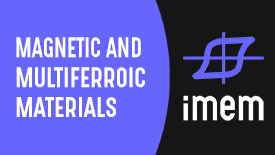Magnetic nanoparticles (MNPs) are an important class of nanomaterials widely studied for biomedical applications, and in particular for their great potential in theranostics (a combination of specific targeted therapy and specific targeted diagnostics). They can be applied in contrast-enhancing, cell labelling, manipulation and separation for lab-on-chip diagnostics, drug and gene delivery, magnetic hyperthermia and magnetomechanical cancer treatments and more generally as activators of thermo-mechanosensitive cellular functions for several therapeutic approaches.
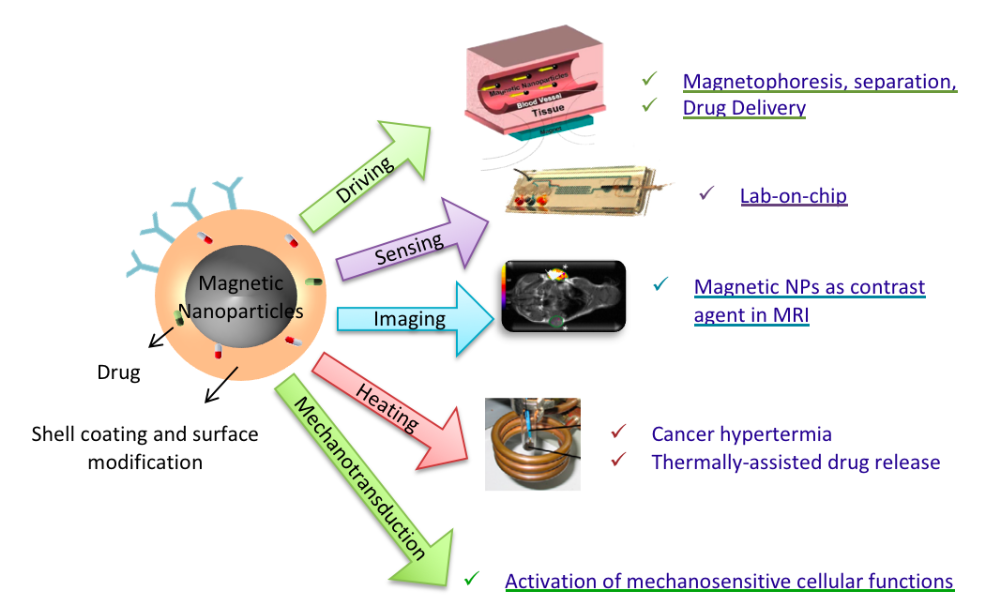
This impressively wide range of applications is based on the basic properties of magnetic entities: they can be remotely detected and driven and can change their physical properties in response to applied magnetic fields (e.g change of temperature, shape, resistivity ...). Fe-based oxides nanoparticles are up to now the most studied materials for their biocompatibility. Multifunctional nanocomposites and intrinsic multifunctional materials are of great interest for further widening the application range.
Magnetic materials and magnetic technologies are also crucial for the production of suitable magnetic fields for biomedical applications (e.g. magnetophoresis, imaging, hyperthermia, magnetic stimulation...) and for the realization of sensors for health and biomedicine.
Our research is mainly addressed to
- Magnetic nanoparticles for magnetic hyperthermia, drug delivery and bio-medical application
- Realization of magnetic materials and technologies for sensors and magnetophoresis
Magnetic nanoparticles for magnetic hyperthermia and multi-therapeutic approaches
Magnetic hyperthermia is a promising therapeutic approach to complement chemotherapy and radiotherapy for cancer treatment, aimed at locally inducing the death of cancer cells. It exploits the heating of magnetic nanoparticles when subjected to a r.f. magnetic field. The transformation of the radiofrequency field energy into heat occurs by several mechanisms and the process efficiency strongly depends on the frequency and amplitude of the external field, as well as on the particle characteristics and in particular: size, shape and inter-particle interactions.
The hyperthermia efficiency can therefore be improved by adjusting and tuning these parameters, permitting the use of (i) lower magnetic NP amounts and (ii) fields at lower frequencies and amplitudes.
Highlights
-
Magnetic interactions and hyperthermic response of Fe-oxide nanoparticles
Magnetic hyperthermia strongly depends on size and shape of magnetic nanoparticles and on interparticle interactions. Chemical preparation methods allow to control shape and size (e.g. by controlled aggregation from multicore aggregated nanoparticles to regular single crystals) and particle magnetic properties and interparticle magnetic interactions. By making use of advanced magnetic and microstructural approaches, including Lorentz microscopy we have deepened the link between the magnetic properties and interactions and the hyperthermic response in Fe-oxide based nanoparticles (https://doi.org/10.1039/C6CE01252C, https://doi.org/10.1039/C5NR00273G).
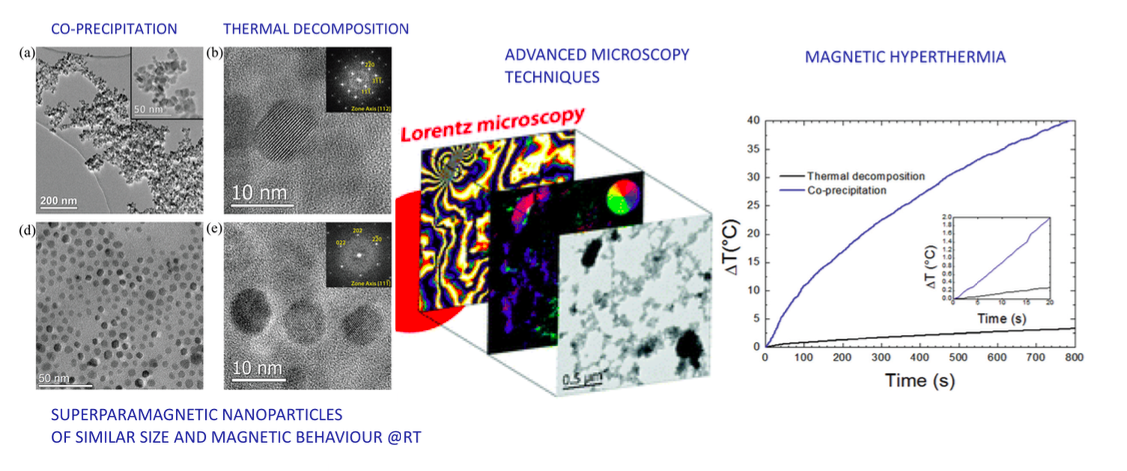
From: https://doi.org/10.1039/C5NR00273G
-
Magnetic oxygen-loaded nanobubbles for multifaced cancer treatment
Magnetic oxygen-loaded nanobubbles (MOLBN) are a new interesting theranonstic tool for multifaced tumor treatment. They show echogenicity, hyperthermic properties and internalization capability. Their hyperthermic response upon RF magnetic field exposure, together with the release of oxygen as radiosensitizer for radiotherapy , provide a new approach for cancer treatment therapy.
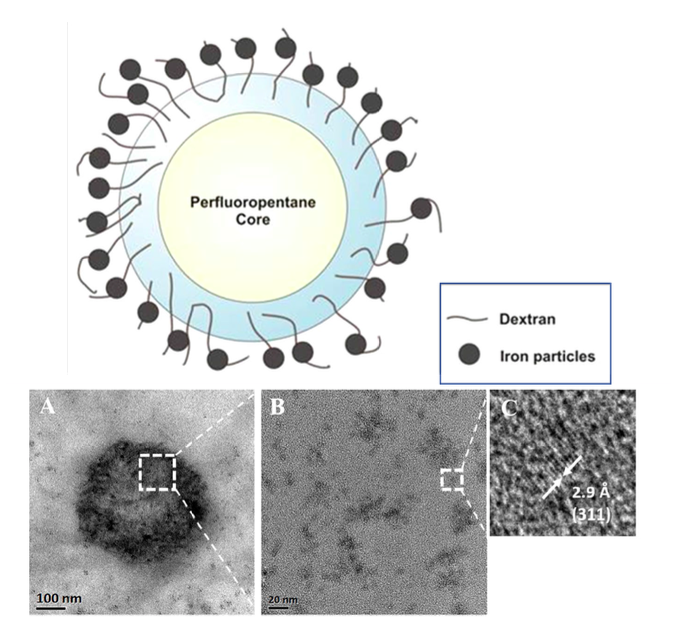
(A) TEM images of MOLBN; (B) HRTEM image of the square region in (A); (C) HRTEM image of the square region in (B) showing the (311) lattice planes of Fe3O4 nanoparticles.
From https://doi.org/10.3389/fphar.2019.01001
Main publications
- "Superparamagnetic Oxygen-Loaded Nanobubbles to enhance tumor oxygenation during hyperthermia" - S. Zullino, M.Argenziano, S. Ansari, R. Ciprian, L. Nasi, F. Albertini, R. Cavalli, C. Guiot, Front. Pharmacol. 10 (2019) 1001. -https://doi.org/10.3389/fphar.2019.01001
- “Tuning morphology and magnetism of magnetite nanoparticles by calixarene-induced oriented aggregation” - F. Vita, H. Gavilan, F. Rossi, C.D. Fernandez, A. Secchi, A. Arduini, F. Albertini, M.P. Puerto Morales, Crystengcomm 18 (2016) 8591. https://doi.org/10.1039/C6CE01252C
- "Lorentz microscopy sheds light on the role of dipolar interactions in magnetic hyperthermia”- M. Campanini, R. Ciprian, E. Bedogni, A. Mega, V. Chiesi, F. Casoli, C. de Julian Fernandez, E. Rotunno, F. Rossi, A. Secchi, F. Bigi, G. Salviati, C. Magen, V. Grillo, F.Albertini “, Nanoscale 7 (2015) 7717. https://doi.org/10.1039/C5NR00273G
- “Hybrid Polyelectrolyte/Fe3O4 Nanocapsules for Hyperthermia Applications” - L. Cristofolini, K. Szczepanowicz, D. Orsi, T. Rimoldi, F. Albertini, P. Warszynski, ACS Applied Materials & Interfaces 8 (2016) 25043. https://doi.org/10.1021/acsami.6b05917
- “Ni80Fe20 nanodisks by nanosphere lithography for biomedical applications” - P. Tiberto, G. Barrera, F. Celegato, G. Conta, M. Coisson, F. Vinai, F. Albertini, J. Appl. Physics 117 (2015) 17B304 https://doi.org/10.1063/1.4913278
Magnetoplasmonic nanoparticles
Magnetoplasmonics (MPs) is a new materials science subject that investigates the novel phenomena and the multifunctional properties of materials that exhibit simultaneous plasmonics and magnetic phenomena. MPs materials are typically hybrid hetero-nanostructures, composed by a noble metal moiety, that exhibit a strong surface plasmon resonance (SPR), and a magnetic moiety, metallic or oxide, with permanent magnetization. Due to the nanometric and hybrid nature of the NPs, size and interface effects modify and intertwin the optical and magnetic properties of each moiety giving rise to novel phenomena. The research of MAGFUN team is focused in:
- Development of magnetoplasmonics structures like multilayers and core@shell nanoparticles and heterodimers with localized plasmons
- Investigation of the modification of the magnetic and plasmonic properties and the correlation with the morphology and interface effects
- Plasmon induced magneto-optical effects and spin plasmonic phenomena
- MPs structures for biomedical and sensing applications
Highlight
Magnetic, optical and hyperthermia properties of Core@Shell Au@Fe oxide nanoparticles
The structural, magnetic and optical properties of Au@Fe oxide NPs were investigated and compared with the corresponding Fe oxide NPs in which Au moiety was removed by chemical methods. Both magnetic and plasmonic properties are dumped in the MPs systems. They exhibit a weaker and red-shifted plasmon resonance with respect to bare Au nanoparticles due to the optical absorption of the Fe oxide. Specific magnetization is very small due to the magnetic disorder in the Fe oxide and due to the presence of antiferromagnetic FeO at the Au- Fe oxide interface. MPs nanoparticles exhibit heating under radiofrequency irradiation. Hence, they exhibit plasmonic, magnetic and hyperthermia properties, being promising a material for multifunctional applications required in biomedicine.
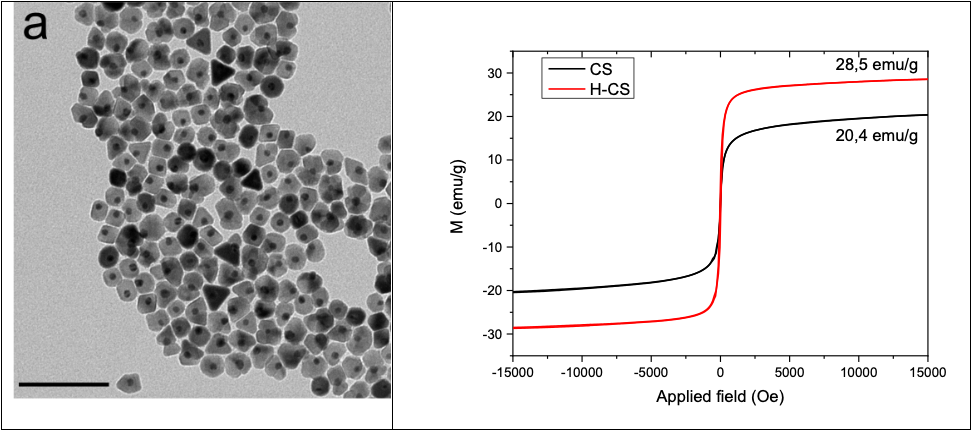 (a) TEM picture of Core@Shell (CS) Au@Fe oxide nanoparticles
(a) TEM picture of Core@Shell (CS) Au@Fe oxide nanoparticles
(b) Comparison of the hysteresis loops of CS MPs nanoparticles with the loop of the nanoparticles after etching of Au moiety (H-CS)
Reproduced by permission of The Royal Society of Chemistry
From: 10.1039/c8tc01788c
Main publications
- “Plasmon-enhanced magneto-optical detection of single-molecule magnets” - F. Pineider, E. Pedrueza-Villalmanzo, M. Serri, A. Mekonnen Adamu, E. Smetanina, V. Bonanni, G Campo, L. Poggini, M. Mannini, C.de Julián Fernández, C. Sangregorio, M. Gurioli, A. Dmitriev and R. Sessoli - Materials Horizons 6 (2019) 1148-1155 - Doi:10.1039/c8mh01548a
- “Addressing the influence of localized plasmon resonance on the magneto-optical properties of cobalt ferrite nanoparticles” -G. Campo, F. Pineider, E. Fantechi, C. Innocenti, A. Caneschi, C. de Julián Fernández - Journal of Nanoscience and Nanotechnology – Special Issue on Spinel Ferrite 19 (2019) 4946–4953 - Doi:10.1166/jnn.2019.16799
- “Colloidal Au/Iron Oxide Nanocrystal Heterostructures: Magnetic, Plasmonic and Magnetic Hyperthermia Properties” - F. Vita, C. Innocenti, A. Secchi, F. Albertini, V. Grillo, A. Vincenzo, P. D. Cozzoli, C. de Julián Fernández - Journal Materials Chemistry C (2018) 109 - https://doi.org/10.1039/C8TC01788C
- “Tailoring nanostructured surfaces with plasmonic/magnetic multifunctional response” - A. Serrano, O. Rodríguez de la Fuente, M. García-Hernández, G. Campo, C. de Julián Fernández, J. F. Fernández and M. A. García - Applied Physics Letters, 113, (2018) 101908 -101911- DOI: 10.1063/1.5044697
- “Modelling and nanoscale characterization of noble/ferromagnetic metal multilayers for enhanced magneto-plasmonic biosensing" - M. G. Manera, G. Pellegrini, P. Lupo, C. de Julián Fernández, F. Casoli, S. Rella, C. Malitesta, F. Albertini, G. Mattei, R. Rella- Sensors & Actuators: B. Chemical 239 (2017) 100–112 - DOI: 10.1016/j.snb.2016.07.128








